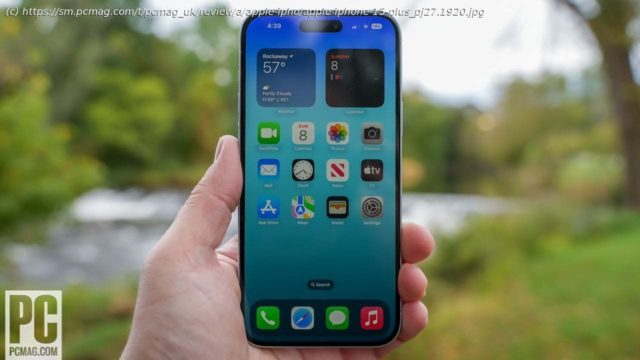A bigger screen and longer battery life make a difference
Apple’s iPhone 15 Plus (starting at $899) takes everything good about the iPhone 15 (starting at $799) and dials it up a notch with a bigger screen and longer battery life. This second iteration of the Plus model features a revised design, a brighter display, and a step forward in performance compared with its predecessor, all while keeping the starting price unchanged. It’s about the same size as the 15 Pro Max (starting at $1,199), but easier on the wallet. Ultimately, the Pro Max is our Editors’ Choice winner for its advanced features, but the 15 Plus is a fine alternative if you want most of what that phone offers for less money. More to Like
Generally speaking, the iPhone 15 Plus is just a larger iPhone 15. It’s the same feature-for-feature and spec-for-spec other than the battery, screen, and size. Much more separates the regular iPhones from the Pro models, such as a more powerful new processor and the addition of a telephoto camera in the Pro.
Aside from the slightly modified shape and the adoption of USB-C, nearly all other design aspects here are similar to the iPhone 14 Plus. Starting with the shape, Apple softened up the joint between the aluminum frame and glass panels by rounding out the metal. This small tweak greatly improves the feel of the phone in your hand. The 15 Plus is available in a really nice matte black as well as light blue, green, pink, or yellow. To achieve these finishes, Apple says it used a new method of infusing the color directly into the glass.
The phone’s dimensions and weight are practically identical to its predecessor at 6.33 by 3.06 by 0.31 inches (HWD) and 7.09 ounces. Last year’s Plus model came in at 6.33 by 3.07 by 0.31 inches and 7.16 ounces. The standard iPhone 15 is markedly smaller at 5.81 by 2.82 by 0.31 inches and 6.02 ounces, while the 15 Pro Max is close at 6.29 by 3.02 by 0.32 inches and 7.81 ounces. On the Android front, the $999 Samsung Galaxy S23+ measures 6.21 by 3.0 by 0.30 inches and weighs 6.91 ounces, while the $999 Pixel 8 Pro measures 6.4 by 3.0 by 0.3 inches and 7.5 ounces.
Apple’s Ceramic Shield protects the screen, though it doesn’t say what type of glass the rear panel uses. All four iPhone 15 models meet the IP68 rating for resistance to dust and water. The iPhone 15 Plus can sit in up to six meters of water for up to 30 minutes, according to Apple. We still think you should cover it with a protective case to be safe.
The 15 Plus doesn’t have the new Action button you get with the Pro models. It carries over the legacy ringer switch, which sits high on the left edge of the phone. Other controls include two volume buttons on the left and a power/screen lock button on the right. They all work well.
Apple has finally swapped out the old Lightning port in favor of USB-C. On the iPhone 15 and 15 Plus, the USB 2.0 port is capable of data transfer speeds of 480Mbps (the same as Lightning), as well as mirroring video out via an adapter. The Pro models have a faster version of USB-C that handles 10Gbps data speeds and can send video capture signals to external hard drives for recording, provided you buy the right cable. A Bigger Canvas
The 6.7-inch, 2,796-by-1,290-pixel OLED screen is one of the primary reasons to pick the iPhone 15 Plus over the standard 6.1-inch, 2,556-by-1,179-pixel model (all four iPhone 15s have a pixel density of 460ppi). It has all the same features, but that 0.6-inch size difference gives movies, photos, and websites a bit more room to breathe. The 15 Plus display has a two-million-to-one contrast ratio and varying brightness of 1,000 nits (typical), 1,600 nits (HDR), and 2,000 nits (peak outdoor). We found it easy to read outdoors under direct sunlight.
The phone does away with the unsightly notch of the 14 Plus and instead adopts Apple’s Dynamic Island. This section near the top of the display hides the TrueDepth and Face ID cameras. Rather than simply cede the area to darkness, Apple dresses it up with dynamic content that lets you interact with select apps such as Apple Music, the clock, timers, and more. This is a great upgrade for the 15 and 15 Plus, but neither phone gets the useful always-on display of the Pro models.
Another thing the 15 Plus doesn’t get? An adaptive refresh rate. The 15 and 15 Plus both have static 60Hz displays even though many Android phones in the same price range have 90Hz or 120Hz panels. Apple is relying on the faster adaptive refresh rate of the Pro models as a differentiator between the lines. Faster refresh rates lead to smoother experiences when you interact with the screen.Plenty of Power
The iPhone 15 and 15 Plus share the same specs when it comes to the processor, memory, and storage. That means Apple’s A16 Bionic processor is running the show: It is manufactured with a 4nm process and is carried over from the 14 Pro models from 2022. It’s still a capable chip thanks to its six-core configuration, which includes two performance cores at 3.46GHz and four efficiency cores. A five-core GPU pushes the polygons and a 16-core Neural Engine handles machine learning tasks. The 15 Plus has 6GB of RAM and comes with either 128GB ($899), 256GB ($999), or 512GB ($1,199) of storage.






